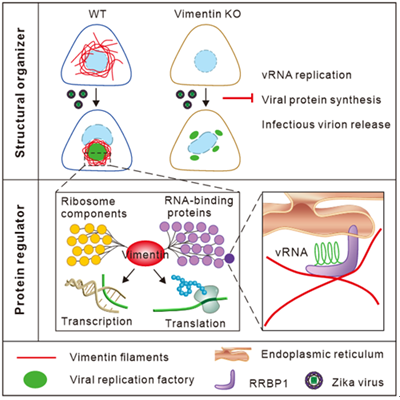Host cytoskeletal vimentin serves as a structural organizer and an RNA-binding protein regulator to facilitate Zika viral replication
In the study published in the journal Proceedings of the National Academy of Sciences of the United States of America (PNAS) on 22. 02. 2022, entitled Host cytoskeletal vimentin serves as a structural organizer and an RNA-binding protein regulator to facilitate Zika viral replication, Prof. JIU Yaming’s group at Institut Pasteur of Shanghai, the Chinese Academy of Sciences discovered a dule-role of vimentin underlying ZIKV replication by using advanced imaging techniques and omics analysis.
In this study, vimentin filaments undergo drastic reorganization upon viral protein synthesis to form a perinuclear cage-like structure that embraces RCs, gather important host factors and virus components, and interact with many endoplasmic reticulum proteins such as RRBP1 to promote viral RNA replication. According to the researchers, knockout of vimentin dispersed the components of ZIKV RC, and reduced ZIKV genome, viral protein synthesis and infectious virion production without affecting viral binding and entry to the host cell.
Further investigation revealed many host RNA-binding proteins interact with and being regulated by vimentin during ZIKV infection. Thereinto, the cytoplasmic-region of ribosome receptor binding protein 1 (RRBP1), an ER transmembrane protein that directly binds viral RNA, interacted with and was regulated by vimentin. Depletion of vimentin dispersed the location of RRBP1 on ER, reduced expression level of RRBP1 and colocalization between RRBP1 and viral dsRNA.
Interestingly, depletion of vimentin resulted in ER dispersion in both uninfected and ZIKV-infected condition. Together, the physical contact and biological association between vimentin and ER guarantee the accurate location and function of viral RCs by interacting and regulating multiple critical ER-located proteins involved in viral replication.
These findings fill the long-term gap in our knowledge of the cellular function of intermediate filaments in addition to structural support and provide a potential target for ZIKV therapy. This work was supported by the Chinese Academy of Science, National Natural Science Foundation of China and Ministry of Science and Technology of China, etc.

Proposed model for dual roles of vimentin during ZIKV infection. (Image by IPS)